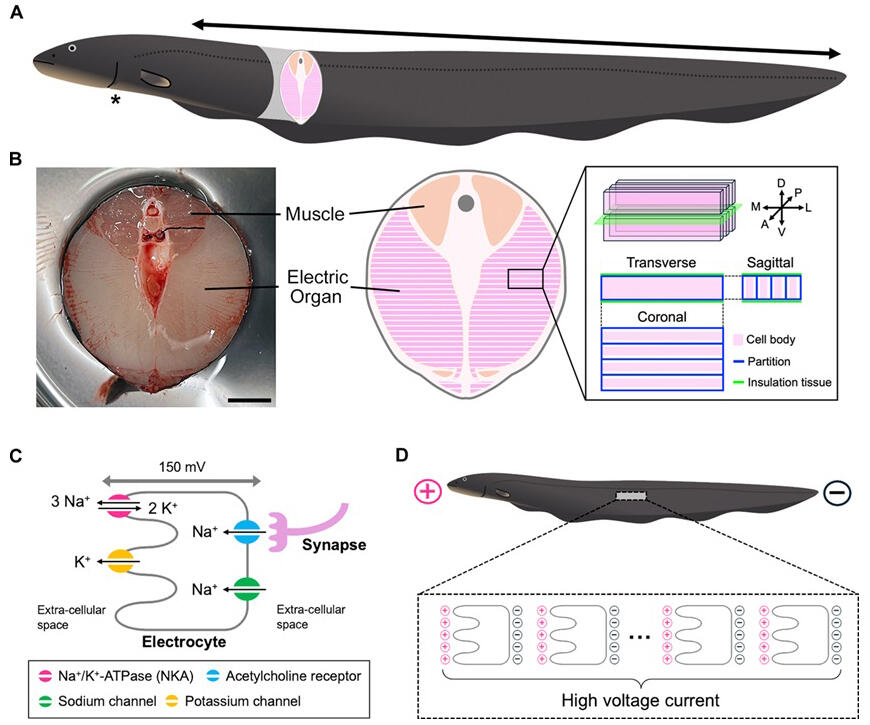Electric eels are the largest and most powerful electricity-generating organisms on Earth. They live in South America and have recorded maximum voltages reaching 860 volts. They became known worldwide through Humboldt's 18th-century reports as fish capable of knocking out horses. The principle behind their electricity generation is thought to be an enhancement of the membrane potential mechanism that all living organisms possess. However, it remains unclear what genetic functions actually cause cells to transform into electrocytes and enable high-voltage discharge.
A research group led by Assistant Professor Atsuo Iida and Professor Eiichi Hondo from the Graduate School of Bioagricultural Sciences, along with Professor Makoto Kuwahara from the Institute of Materials and Systems for Sustainability at Nagoya University, conducted joint research with the Institute of Science Tokyo and Prince of Songkla University (Thailand) to newly discover cell populations resembling undifferentiated cells in electric eel electric organs. By investigating the genes working in these cells, the formation process of electrocytes may be elucidated, potentially making it possible to artificially create electricity-generating cells. Their research was published in Developmental Biology.

B. A photograph and illustration of the transverse section of the tail region of Electrophorus. The medial-lateral lines in the mEO indicate the outer edge of the multinucleated electrocytes. The plate-shaped electrocytes are stacked along the anterior-posterior and dorsal-ventral axes. SM, skeletal muscle. mEO, main electric organ. Scale bar, 1 cm.
C. Schematic model illustrating the generation of membrane potential in an electrocyte, with ion transporters localized anteriorly or posteriorly on the cell surface, generating approximately 150 mV current due to synaptic input.
D. Electrocytes arranged along the anterior-posterior axis, enhancing membrane potential leading to high-voltage discharge.
Provided by Nagoya University
To search for electrocytes precursor cells, the research group prepared tissue specimens of electric eels and thoroughly observed regions corresponding to electric organs under the microscope, discovering cell populations composed of mononuclear cells in the ventral terminal portion of the electric organ region.
There was continuous transition from these cell populations to mature electrocytes (syncytia), suggesting they contain electrocyte precursor cells. Mature electrocytes possess abundant proteins with ion transport functions for generating electricity (membrane potential). Through immunohistochemistry, the researchers visualized the presence of NKA (Na+/K+-ATPase), one of the ion transport proteins, in tissue specimens.
They found that NKA was abundantly present in dorsal mature electrocytes (syncytia), but NKA could not be detected in ventral terminal mononuclear cells. This suggests that the ventral mononuclear cells are immature cells incapable of generating electricity.
This research identified cell populations that appear to be the most promising candidates for electrocyte precursor cells. Once their existence is clarified, it will become possible to investigate genetic information expressed within these cells. The next step is comprehensive gene expression analysis using next-generation sequencing. Although some methodological trial and error will be necessary in addition to cost and effort, this is certainly considered achievable. The researchers will take on the challenge of experiments to reproduce electrocyte differentiation using the genetic information obtained.
Journal Information
Publication: Developmental Biology
Title: Ventral-to-dorsal electrocyte development in electric organs of electric eel (Electrophorus)
DOI: 10.1016/j.ydbio.2025.05.003
This article has been translated by JST with permission from The Science News Ltd. (https://sci-news.co.jp/). Unauthorized reproduction of the article and photographs is prohibited.




